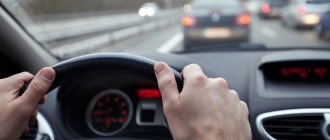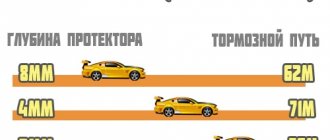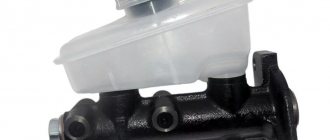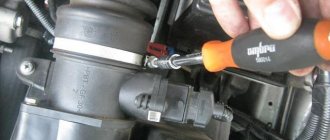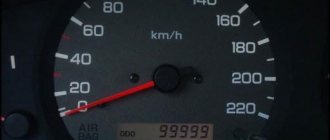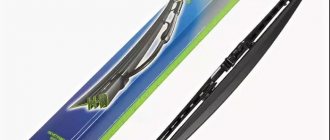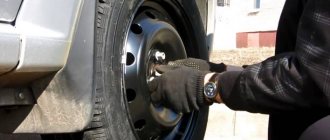Home » Domestic auto industry
Reading time: 12 minutes. Updated 08/04/2019
Braking distance is the distance it takes for a vehicle to come to a complete stop from the moment the braking system begins to operate.
In everyday life, this term is often confused with stopping distance, but braking distance and stopping distance are different concepts. In the latter case, the distance elapsed from the moment the driver realized the need to brake to a speed of 0 km/h is taken into account. The braking distance is part of the stopping distance.
What does braking distance depend on?
The indicator under consideration is not a constant value and can vary for a number of reasons. All factors influencing the braking distance can be divided into two large groups: driver-dependent and driver-independent. Reasons beyond the control of the person driving include:
It is easy to guess that in rain, snow or ice, the distance required to stop a car will be greater than on dry asphalt. Braking will also take a long time when driving on smooth asphalt, to which stone chips have not been added. Here the wheels have nothing to catch on, unlike rough surfaces.
Note: it is worth noting that poor quality of the road (potholes, potholes) does not lead to an increase in the distance required to stop. The human factor plays a role here. Trying to save the suspension, drivers rarely reach high speeds on such roads. Accordingly, the braking distance here is minimal.
Factors depending on the driver or owner of the car:
- brake condition;
- system design;
- presence of ABS;
- type of tires;
- vehicle load;
- movement speed.
The fact that the length of a car’s braking distance directly depends on the serviceability of the braking system does not require proof. A car with a malfunctioning brake circuit or worn out pads will never be able to stop as quickly as a working vehicle.
A lot depends on the design of the brake units. Modern cars equipped with rear disc brakes and brake assist systems have much better traction and shorter braking times.
In turn, the presence of EBD with ABS does not always help reduce the distance required to stop. On dry hard surfaces, where wheel locking occurs only with very intense braking, the system actually shortens the braking distance. However, on bare ice, the “smart” electronic assistant begins to reduce braking force even when you lightly press the brake pedal. At the same time, the car retains controllability, but its braking distance increases significantly.
What determines the rate of deceleration? Of course, it depends on the type of tires. So, on bare, albeit frozen, asphalt, as well as in slushy snow, the so-called brakes are best. “Velcro” are winter tires that are not equipped with studs. In turn, in icy conditions and on snowy roads, studded tires are the most effective. » alt=»»> An important factor influencing the size of the stopping distance is the speed and load of the machine.
It is clear that a lightweight car at a speed of 60 km/h will stop faster than a truck loaded to capacity and moving at a speed of 80-100 km/h. The latter will not be allowed to stop quickly by speed and inertia that is too high for him.
Origin of the myth
Where did the driver's stereotype come from, that the heavier the car, the longer the braking distance?
From practice, when we use service braking every day. We’re used to driving alone, we’re used to braking at the same traffic lights so many meters away and pressing the pedal so many centimeters. Then we fill the cabin with passengers and the trunk with things, and at the same traffic light the car slows down worse and drives further.
Here is the root of the misconception: the car drives further with the same, familiar movement of the brake pedal
. It is able to stop as quickly and with the same braking distance as in the case of one driver in the cabin. You just need to press the brake a little harder than the driver is used to. And this scheme will work until the ABS is activated - the limit of braking capabilities. Accordingly, the ABS will turn on both when the car is empty and when the car is full. Just to turn it on with a full car, you need to hit the pedal a little harder than is required with an empty car.
A few years ago, my friends and I had an argument on this topic; they tried to prove me wrong and, as confirmation, cited the result of an experiment by 9th grade students in one of the Moscow schools. The guys took the Gazelle and studied in practice the dependence of the braking distance and braking time of a school taxi on speed and weight. It’s clear that in their experiment, a car loaded with people drove further on each run than an empty one. Because the schoolchildren used standard braking and, apparently, compared the braking distance of cars with different loads with the same pressure on the brake pedal. If they braked urgently, skidding, the braking distance would be the same in both cases. But emergency braking on a busy school street is extremely unsafe, and it requires considerable skill.
What determines the average braking distance of any car?
What factors influence braking and stopping distance?
Road conditions
Undoubtedly, the length of the brake line is influenced by the condition of the road surface. On an icy or wet road it can increase significantly. But these are not all the factors. You should also be wary of fallen leaves, on which tires glide perfectly, cracks in the surface, holes, and so on.
Tires
The quality and condition of the rubber greatly influence the length of the brake line. Often, more expensive tires provide better grip on the road surface. Please note that if the tread depth has worn off beyond the permissible value, then the rubber loses its ability to drain a sufficient amount of water when driving on a wet road. As a result, you may encounter such an unpleasant thing as hydroplaning - when the car loses traction and becomes completely uncontrollable.
To shorten the braking distance, it is recommended to maintain optimal tire pressure. Which one exactly - the automaker will answer this question for you. If the value deviates upward or downward, the braking line will increase.
Depending on the coefficient of adhesion of the tires to the road surface, this indicator will vary. Here is a comparative table of the dependence of the braking distance on the quality of the road surface (a passenger car whose tires have an average coefficient of adhesion):
| 60km/h. | 80 km/h. | 90 km/h. | |
| Dry asphalt, m. | 20,2 | 35,9 | 45,5 |
| Wet asphalt, m. | 35,4 | 62,9 | 79,7 |
| Snowy road, m. | 70,8 | 125,9 | 159,4 |
| Ice, m. | 141,7 | 251,9 | 318,8 |
Of course, these indicators are relative, but they clearly illustrate how important it is to monitor the condition of car tires.
Technical condition of the machine
A car can only go on the road in good condition - this is an axiom that does not require proof. To do this, carry out routine diagnostics of your car, make timely repairs and change the brake fluid.
Remember that worn brake rotors can double the brake line.
When and how measurements are taken
Braking distance calculations may be required in the following cases:
- technical testing of the vehicle;
- checking the capabilities of the car after modifying the brakes;
- forensic examination.
As a rule, the formula S=Ke*V*V/(254*Fs) is used in the calculation. Here S is the braking distance; Ke – braking coefficient; V₀ — speed at the start of braking; Фс – coefficient of adhesion to the coating.
The coefficient of road adhesion varies depending on the condition of the surface and is determined according to the following table:
| Road condition | Fs |
| Dry | 0.7 |
| Wet | 0.4 |
| Snow | 0.2 |
| Ice | 0.1 |
The Ke coefficient is a static value and is unity for all the most common passenger vehicles.
Example: how to calculate the braking distance of a car when the speedometer shows 60 km/h in the rain? Given: speed 60 km/h, braking coefficient – 1, adhesion coefficient – 0.4. We count: 1*60*60/(254*0.4). As a result, we get the figure 35.4, which is the braking distance in meters.
The table shows how many meters the car will continue to move until it comes to a complete stop. It should be taken into account that no other indicators are taken into account (turns, potholes on the road, oncoming traffic, etc.). It is doubtful that in real conditions on an icy road, a car will be able to slide for a kilometer without encountering a pole or bump stop.
| Speed | Dry | Rain | Snow | Ice |
| km/h | meters | |||
| 60 | 20,2 | 35,4 | 70,8 | 141,7 |
| 70 | 27,5 | 48,2 | 96,4 | 192,9 |
| 80 | 35,9 | 62,9 | 125,9 | 251,9 |
| 90 | 45,5 | 79,7 | 159,4 | 318,8 |
| 100 | 56,2 | 98,4 | 196,8 | 393,7 |
| 110 | 68 | 119 | 238,1 | 476,3 |
| 120 | 80,9 | 141,7 | 283,4 | 566,9 |
| 130 | 95 | 166,3 | 332,6 | 665,3 |
| 140 | 110,2 | 192,9 | 385,8 | 771,6 |
| 150 | 126,5 | 221,4 | 442,9 | 885,8 |
| 160 | 143,9 | 251,9 | 503,9 | 1007,8 |
| 170 | 162,5 | 284,4 | 568,8 | 1137,7 |
| 180 | 182,2 | 318,8 | 637,7 | 1275,5 |
| 190 | 203 | 355,3 | 710,6 | 1421,2 |
| 200 | 224,9 | 393,7 | 787,4 | 1574,8 |
Possible consequences of collisions
According to the results of technical tests, a strong impact of a moving car on any obstacle corresponds in strength to a fall:
- at 35 km/h - from a 5-meter height;
- at 55 km/h - 12 meters (from the 3rd-4th floor);
- at 90 km/h - 30 meters (from the 9th floor);
- at 125 km/h - 62 meters.
It is clear that a collision of a vehicle with another car or other obstacle, even at low speed, threatens people with injury, and in the worst case, death.
Therefore, in the event of emergency situations, it is necessary to do everything possible to prevent such collisions and perform a detour around the obstacle or emergency braking.
How to increase the intensity of deceleration
From the above, it became clear what is called the braking distance and what this indicator depends on. However, is it possible to reduce the distance required to stop a car? Maybe! There are two ways to do this - behavioral and technical. Ideally, the driver combines both methods.
- Behavioral method - you can reduce the braking distance if you choose a low speed on slippery and wet roads, take into account the degree of load of the car, and correctly calculate the braking capabilities of the car depending on its condition and model year. Thus, a Moskvich developed in 1985 will not be able to brake as effectively as a modern Hyundai Solaris, not to mention more respectable and technologically advanced models.
- Technical method - a method of enhancing braking capabilities, based on increasing the power of the braking system and the use of auxiliary mechanisms. Manufacturers of modern vehicles actively use such methods of improving brakes, equipping their products with anti-lock braking systems, braking assistance systems, using more efficient brake discs and pads.
It should be remembered that reducing the time required to stop is one of the ways to ensure a safe trip. Therefore, every driver must constantly monitor the technical condition of his “iron horse”, promptly maintain and repair the braking system. In addition, it is important to choose the driving speed taking into account the surrounding situation: time of day, road condition, car model, etc.
Every driver has at least once found himself literally a couple of seconds away from an accident when it is vitally important to have time to brake. However, the car cannot stand rooted to the spot on command. The distance that it travels from the moment it starts braking until it comes to a complete stop is called the braking distance. To be able to estimate the braking distance, you need to ensure that it is always less than the distance to the obstacle in the way.
The length of the braking distance depends on many different factors. This includes the driver’s reaction, the level of performance of the car’s braking system, and external factors, such as the track material and weather conditions. And of course, the speed of the car at the moment of braking plays a decisive role. The question arises - how to calculate the braking distance of a car under all these conditions? For general calculations, three main factors are sufficient - the braking coefficient (Ke), the speed of movement (V) and the coefficient of adhesion (Fs) with the road.
Formula for calculating the braking distance of a car
The formula from the table that calculates the braking distance looks like this: S=Ke*V*V/(254*Fs) . The braking coefficient of a conventional light car is equal to one. The adhesion coefficient on a dry surface will be 0.7. For example, let's take the case when a car is moving on a dry road at a speed of 60 km/h. Then the braking distance will be equal to 1*60*60/(254*0.7)=20.25 meters. On ice (Fs=0.1) braking will last seven times longer - 141.7 meters!
Based on the result, we see how much the braking distance of a car from the table depends on the condition of the highway and weather conditions.
How to brake on a motorcycle?
Braking correctly on a motorcycle is quite a difficult task. You can brake with the rear wheel, the front wheel, or both, skid or engine. If you brake incorrectly at high speeds, you can lose your balance. In order to calculate the braking distance of a motorcycle at 60 km/h, we also substitute the data into the formula. Taking into account the different braking coefficient and friction coefficient.
Motorcycle braking distance
Dry asphalt: 23 - 33 meters
- Wet asphalt: 35 - 46 meters
- Mud and snow: 70 - 95 meters
- Ice: 95 - 128 meters
The second indicator is the braking distance when the motorcycle is skidding.
Any vehicle owner should know and be able to calculate the braking distance, and it is better to do this visually.
It should be remembered that if a traffic accident occurs, by the length of the skid that will remain on the road surface, you can determine the speed of the vehicle before colliding with an obstacle, which can indicate that the driver has exceeded the permissible speed and make him the culprit of the incident.
Factors influencing braking distance and driver reaction time:
| Factors influencing driver reaction time | - Weather — Visibility conditions (poor visibility, night, or bright sun) — Driver’s condition (fatigue, intoxication) — Individual driver experience |
| Factors influencing the braking distance | — Serviceability of the brake system (obviously) — Tire condition (tread height, air pressure) — Manufacturer, brand and type of tires (winter, summer, Velcro) — Vehicle weights (car, truck, empty, loaded) — Availability of ABS and other modern auxiliary systems — Movement speed (one of the main factors) |
Emergency braking
Emergency (emergency) braking is used when there is a danger of a collision or collision.
You should not press the brake too sharply or too hard - in this case, the wheels will lock, the car will lose control, and it will begin to skid along the road.
Symptoms of locked wheels during braking:
- the appearance of wheel vibration;
- reducing vehicle braking;
- the appearance of a scraping or squealing sound from tires;
- The car has skidded and does not respond to steering movements.
IMPORTANT: If possible, it is necessary to perform a warning brake (half a second) for cars following behind, release the brake pedal for a moment and immediately begin emergency braking.
Types of emergency braking
1. Intermittent braking - press the brake (without allowing the wheels to lock) and release completely. Repeat this until the machine stops completely.
When you release the brake pedal, you need to align the direction of movement to avoid skidding.
Intermittent braking is also used when driving on slippery or uneven roads, braking before potholes or icy areas.
2. Step braking - press the brake until one of the wheels locks, then immediately release the pressure on the pedal. Repeat this until the machine stops moving completely.
When you release pressure on the brake pedal, you need to align the direction of movement with the steering wheel to avoid skidding.
3. Engine braking on cars with a manual transmission - press the clutch, change to a lower gear, use the clutch again, etc., alternately lowering to the lowest.
In special cases, you can lower the gear not in order, but several at once.
4. Braking with ABS: if a passenger car has an automatic transmission, during emergency braking it is necessary to press the brake as hard as possible until it comes to a complete stop, and on cars with a manual transmission, simultaneously press firmly on the brake and clutch pedals.
When the ABS system is activated, the brake pedal will twitch and a crunching sound will appear. This is normal, you should continue to press the pedal as hard as you can until the car stops.
PROHIBITED: During emergency braking, use the parking brake - this will lead to the car turning around and uncontrolled skidding due to the complete blocking of the car's wheels.
Car braking distance table
The table shows the approximate average braking distances on a horizontal section of the road for passenger cars, for different road surfaces and their conditions (dry, wet, snow, ice), at various speeds from 10 to 120 km/h.
| Type of road surface | Coating condition | Vehicle speed, km/h | |||||
| 10 | 20 | 30 | 40 | 50 | 60 | ||
| Vehicle braking distance, m | |||||||
| Asphalt concrete | Dry | 0.57—0.49 | 2.25—1.95 | 5—4.4 | 9—7.85 | 14.1—12.3 | 20.3—17.8 |
| Wet | 1.3—0.99 | 5.25—3.95 | 11.8—8.9 | 21—15.7 | 33—24.5 | 47.4—35.5 | |
| Crushed stone highway | Dry | 0.66—0.57 | 2.7—2.25 | 5.9—5 | 10.4—9 | 16.5—14 | 23.6—20.3 |
| Wet | 1.3—0.99 | 5.25—3.95 | 11.8—8.9 | 21—15.7 | 33—24.5 | 47.4—35.5 | |
| Stone ends | Dry | 0,99—0.66 | 3.15—2.7 | 7.1—5.9 | 12.5—10.4 | 19.7—16.5 | 28.4—23.6 |
| Wet | 1.3—1.1 | 5.25—4.5 | 11.8—10 | 21—18 | 33—28 | 47.4—40.5 | |
| Dirt road, clay | Dry | 0.99—0.66 | 3.15—2.7 | 7.1—5.9 | 12.5—10.7 | 19.7—16.5 | 28.4—23.6 |
| Wet | 1,97—1.3 | 7.85—3.95 | 17.6—8.8 | 31.4—15.7 | 49.4—24.5 | 70.6—35.5 | |
| Sand | Dry | 1.3—0.99 | 3.95—3.15 | 8.9—7.1 | 15.7—12.5 | 24.5—19.7 | 35.5—28.4 |
| Wet | 0.99—0,66 | 3.15—2.17 | 7,1—5.9 | 12.5—10.4 | 19.7—16.5 | 28.4—23.6 | |
| Compacted slag | Dry | 0.99—0.66 | 3.15—2.7 | 7.1—5.9 | 12.5—10.4 | 19.7—16.5 | 28.4—23.6 |
| Compacted snow | — | 1.97—1.3 | 7.85—5.25 | 17.6—11.8 | 31.4—21 | 49.4—33 | 70.6—47.4 |
| Icy road | — | 4.9—3.9 | 19.7—15.7 | 44—35.4 | 79—63 | 123—98 | 177—142 |
| Type of road surface | Coating condition | Vehicle speed, km/h | |||||
| 70 | 80 | 90 | 100 | 110 | 120 | ||
| Vehicle braking distance, m | |||||||
| Asphalt concrete | Dry | 25.6—24.2 | 37—31.5 | 45.7—40 | 56.3—49.3 | 63.2—59,9 | 81.4—71.4 |
| Wet | 64.5—48.5 | 83.8—63 | 106—80 | 131.5—97.5 | 158.5—118.5 | 188.5—141.5 | |
| Crushed stone highway | Dry | 32.2—27.6 | 42—36 | 53.3—45.5 | 65.6—56.4 | 79.5—67 | 94.5—81 |
| Wet | 64.5—43.5 | 83.8—63 | 106—80 | 131.5—97.5 | 158.5—118.5 | 188.5—141.5 | |
| Stone ends | Dry | 38.6—32.2 | 50.3—42 | 64—53.3 | 78.7—65.6 | 95—79.5 | 113—94.5 |
| Wet | 64.4—55.2 | 83.8—71.7 | 106—91.3 | 131.5—113 | 158.5—136 | 188.5—161,5 | |
| Dirt road, clay | Dry | 38.6—32.2 | 50.3—42 | 64—53.3 | 78.7—65.6 | 95—79.5 | 113—94.5 |
| Wet | 97—48.5 | 125.5—63 | 159—80 | 197—97.5 | 237—118.5 | 284—141.5 | |
| Sand | Dry | 48.5—38.6 | 63—50.3 | 80—64 | 97.5—78.7 | 111.5—95 | 141.5—113 |
| Wet | 38.6—32.2 | 50.3—42 | 64—53.3 | 78.7—65 6 | 95—79.5 | 113—94.5 | |
| Compacted slag | Dry | 38.6—32.2 | 50.3—42 | 64—53.3 | 73.7—65.6 | 95—79.5 | 113—94.5 |
| Compacted snow | — | 97—64,5 | 125.5—83.8 | 159—106 | 197—78.7 | 237—158.5 | 284—183.5 |
| Icy road | — | 240—193 | 315—252 | 398—316 | 494—394 | 593—475 | 706—575 |
The graph below shows the braking distance of a car on winter tires of different manufacturers and brands, on wet and dry asphalt.
Braking in different conditions
The length of the braking distance is inversely proportional to the coefficient of adhesion to the road. Simply put, the worse the road holds, the longer the car slows down. Let's look at the changes in the coefficient (Fs) in more detail:
- with dry asphalt - 0.7;
- on wet asphalt - 0.4;
- if the snow is rolled - 0.2;
- icy road - 0.1.
These numbers allow us to see how stopping distances will change depending on conditions. As already mentioned, at a speed of 60 km/h on a dry road the car will brake in 20.25 meters, and on ice - 141.7. On a wet track the braking distance will be 35.4 meters, and on a snowy track - 70.8.
Safe distance between cars
According to clause 13.1 of the Traffic Rules, the driver must keep a sufficient distance from the vehicle in front that will allow him to brake in time.
Failure to maintain distance is one of the main causes of transport accidents.
When a vehicle in front comes to a sudden stop, the driver of a car closely following him does not have time to brake. The result is a collision between two and sometimes more vehicles.
To determine the safe distance between cars while driving, it is recommended to take an integer speed value. For example, the speed of a car is 60 km/h. This means that the distance between him and the vehicle in front should be 60 meters.
Types of braking
It is also worth considering that the method of braking plays a big role:
- A sharp press can send the car into an uncontrolled skid.
- Gradually pressing the pedal will work if there is good visibility and time to spare, but it cannot be used in an emergency situation.
- Intermittent braking with several presses of the pedal to the stop will allow you to quickly stop the car, but is also fraught with loss of control.
- Pressing in steps will allow you to lock the wheels without losing contact with the pedal.
In winter conditions, ABS will increase the braking distance by 15-30 meters when driving on snow or ice. At the same time, the system will leave the driver control of the car, which can be critically important when driving on ice.
Friction table at different speeds
Remember, the weak points of ABS are muddy soil and clay. The braking distance may also be longer with them than with fully “manual” braking. But control over the car will also remain.
Fact
According to scientists, the driver's reaction to an obstacle is one second. During this time, a car at a speed of 60 kilometers per hour will travel 16 meters. The braking distance itself from this speed will require at least another 16 meters (according to the laws of physics). Therefore, the minimum distance will be 32 meters. But still, calculations are one thing, but practice is another.
In everyday life, under real conditions, it is almost impossible to achieve such effective braking. However, it is possible. Moreover, all calculations are made in such a way that the driver looks carefully at the road and to the sides. And if in an emergency you smoke, talk on the phone or switch the radio, this is out of the question. In such cases, braking distance is critical, and in many cases you simply will not stop, or you will do so after hitting someone.
How to determine the speed of a car based on the braking distance?
In cases where it was still not possible to brake in time, it is necessary to determine at what speed the vehicle was moving at the moment the braking began. The general formula for calculating the “starting” braking speed looks like this - V = 0.5*t3*j + √2*S*j . In this case, the following factors play a role:
- tЗ is the rise time of the machine deceleration. Measured in seconds;
- j - deceleration of the car when braking. Measured in m/s2. According to GOST on a dry route j=6.8 m ;
- s2 , and on wet - 5 m/s2;
- S is the length of the braking trail.
Let's take conditions in which tЗ = 0.3 seconds, the braking trail is 20 meters, and the track is dry. Then the speed is 0.5*0.3*6.8 + √2*20*6.8 = 1.02 + 19.22 = 20.24 m/s = 72.86 km/h.
Basically, three methods are used to determine the speed at the beginning of braking:
- Determination by braking distance.
- Determination by the law of conservation of momentum.
- Determination by car deformation.
The advantages of the first method are simplicity and speed, a large number of studies, and accurate results. The good thing about the second method is that it can be used when there are no signs of braking, it gives an accurate result and is useful when colliding with stationary cars. The third differs in that it takes into account the energy consumption for the deformation of the machine.
Each method also has its own disadvantages. In the first case, it is impossible to use in the absence of tire marks. In the second there are cumbersome calculations, and in the third there are large volumes of what needs to be taken into account and low accuracy of calculations.
Speed.
As you can see above in the picture and in the table itself, high vehicle speed results in longer braking distances. But in addition to the speed itself, as you can see, the speed of your reaction before you press the brake pedal also plays an important role. On average, most drivers have approximately the same speed of reaction to an emergency situation on the road when making a decision to brake. As we can see from the table, the higher the speed, the longer the distance traveled until the very moment we press the brake pedal. And this takes into account the fact that the speed of our reaction does not change.
Important to know: How to check brake fluid
This is a compelling argument to encourage drivers not to violate the speed limit. This is especially necessary in populated areas within the city. This is why many cities have speed limits of 40 km/h.
Road conditions.
You also need to know that on a wet or icy road, the braking distance certainly increases. The fact is that on a slippery surface, the car’s grip on the road is greatly reduced, which leads to an increase in braking distance when braking.
For example, in icy conditions the braking distance of any car can increase tenfold!
Technical condition of the vehicle
Of course, any car should only go on the road in acceptable technical condition. To do this, you need to periodically carry out routine diagnostics of all important vehicle systems, as well as carry out timely maintenance and necessary repairs.
Remember that the technical condition of the car directly affects the braking distance in case of braking.
For example, bad brake pads, brake rotors or drums, and old brake fluid can cause stopping distances to double.
Remember also that in addition to the technical condition of the vehicle, you must keep the car clean. For example, a dirty windshield can cause you to not see something (or not notice it in time) on the road and press the brake pedal too late. As a result, your braking distance may increase significantly, which will naturally lead to an accident.
Dirty headlights may not illuminate the road enough at night. In this case, you risk not noticing the danger on the road in time and reacting too late, thereby increasing the braking distance.
